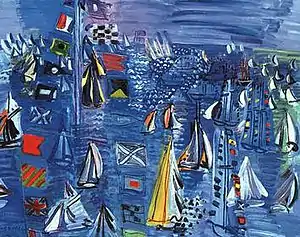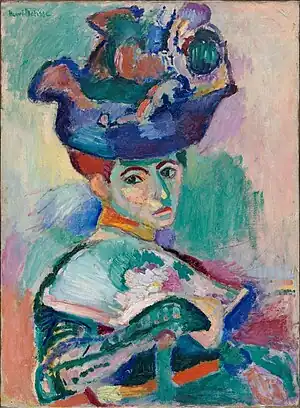Raoul Dufy
Raoul Dufy (French: [ʁa.ul dy.fi]; 3 June 1877 – 23 March 1953) was a French Fauvist painter. He developed a colorful, decorative style that became fashionable for ceramics and textile designs, as well as decorative schemes for public buildings. He is noted for scenes of open-air social events. He was also a draftsman, printmaker, book illustrator, scenic designer, furniture designer and a planner of public spaces.
Raoul Dufy | |
|---|---|
 Raoul Dufy, before 1927 | |
| Born | 3 June 1877 Le Havre, France |
| Died | 23 March 1953 (aged 75) Forcalquier, France |
| Education | École nationale supérieure des Beaux-Arts |
| Known for | Painting, drawing, design, printmaking |
| Notable work | La Fée Electricité (1937) |
| Movement | Fauvism, Impressionism, modernism, Cubism |
Biography
%252C_oil_on_canvas%252C_66_x_81_cm%252C_Mus%C3%A9e_d'Art_Moderne_de_la_Ville_de_Paris...jpg.webp)
Early life
Dufy was born at Le Havre, in Normandy. His younger brother, Jean Dufy, also became an artist. At 14, Dufy left school to work for a coffee-importing company. In 1895, at 18, he began taking evening art classes at Le Havre's École des Beaux-Arts, taught by Charles Lhuillier, a former student of the French portrait painter Ingres. There he met Raimond Lecourt [fr] and Othon Friesz, with whom he later shared a studio in Montmartre and maintained a lifelong friendship. During this period, Dufy primarily painted Norman landscapes in watercolors.
In 1900, after a year of military service, Dufy won a scholarship to the École Nationale supérieure des Beaux-Arts in Paris, where he again crossed paths with Othon Friesz (who was also there when Georges Braque was studying). Dufy focused on improving his drawing skills, influenced by impressionist landscape painters such as Claude Monet and Camille Pissarro. His first exhibition was in 1901, at the Exhibition of French Artists. Dufy was introduced to Berthe Weill in 1902 and showed his work in her gallery. He exhibited again in 1903, at the Salon des Indépendants and received an early confidence boost when artist Maurice Denis bought one of his paintings. Dufy continued to paint, often in the vicinity of Le Havre, particularly on the beach at Sainte-Adresse, made famous by Eugène Boudin and Claude Monet. In 1904, he worked in Fecamp, on the English Channel (La Manche), with his friend Albert Marquet.
Later years

Henri Matisse's Luxe, Calme et Volupté, which Dufy saw at the Salon des Indépendants in 1905, directed his interests towards Fauvism. Les Fauves (the wild beasts) emphasized bright color and bold contours in their work. Dufy's painting reflected this aesthetic until about 1909 when contact with the work of Paul Cézanne led him to adopt a subtler technique. However, it was not until 1920, after he had flirted briefly with yet another style, Cubism, that Dufy developed his own distinctive approach. It involved skeletal structures arranged with foreshortened perspective, and the use of thin washes of color applied quickly, in a manner that came to be known as stenographic. Dufy's cheerful oils and watercolors depict events of the time period, such as yachting scenes, sparkling views of the French Riviera, chic parties and musical events.
For the 1937 Exposition International in Paris, Dufy completed one of the largest paintings ever made, a huge and immensely popular ode to electricity titled La Fée Electricité (painted in oil on plywood).
Dufy also acquired a reputation as an illustrator and commercial artist. He painted murals for public buildings and produced a significant number of tapestries and ceramic designs. His plates appear in books by Guillaume Apollinaire, Stéphane Mallarmé and André Gide.
In 1909, Dufy was commissioned by Paul Poiret to design stationery for the house. After 1912, he designed textile patterns for Bianchini-Ferier, which were used for garments worn by Poiret and Charvet.
In the late 1940s and early 1950s, Dufy exhibited at the annual Salon des Tuileries in Paris. By 1950, his ability to paint was diminished when his hands were impaired by rheumatoid arthritis and he had to fasten a brush to his hand to work. In April he went to Boston to undergo an experimental treatment with cortisone and corticotropin, based on the work of Philip S. Hench. It proved successful, and some of his next works were dedicated to the doctors and researchers in the United States. In 1952 he received the grand prize for painting in the 26th Venice Biennale. Dufy died of intestinal bleeding at Forcalquier, France, on 23 March 1953, likely the result of his continuous treatment. He was buried near Matisse in the Cimiez Monastery Cemetery in Cimiez, a suburb of the city of Nice.
Collections
Among the public collections holding works by Raoul Dufy are:
- Art Institute of Chicago, Chicago, IL, USA[1]
- Art Gallery of Ontario, Ontario, Canada
- Kalamazoo Institute of Arts, Kalamazoo, MI, USA
- McNay Art Museum,[2] TX, USA
- Musée d'Art Moderne de Paris, Paris, France
- Musée des Beaux-Arts de Nice, Nice, France
- Museum de Fundatie, Zwolle, Netherlands
- National Gallery of Art, Washington, D.C., USA
- Van Abbemuseum, The Netherlands
- Virginia Museum of Fine Arts, Richmond, VA, USA
Works
- Hommage à Mozart Archived 2007-10-25 at the Wayback Machine, (Web Gallery Private Art Collection)
- Le 14 juillet au Havre, rue pavoisée Archived 2007-12-17 at the Wayback Machine, (1906, Web Gallery Private Art Collection)
- French modern art exhibition 1939 treasure 3 National Library of Latvia displayed via The European Library
- Works by Raoul Dufy (public domain in Canada)
- Raoul Dufy's artworks in context, Museum of modern art André Malraux
Illustrations
- Jean Cocteau, Bertrand Guégan (1892-1943); L'almanach de Cocagne pour l'an 1920-1922, Dédié aux vrais Gourmands Et aux Francs Buveurs[3]
See also
References
- "Raoul Dufy | The Art Institute of Chicago". The Art Institute of Chicago. Retrieved 2023-09-16.
- McNay Art Museum (2014). "McNay Collection: Raoul Dufy". Mcnayart.org. Archived from the original on 19 August 2016. Retrieved 16 May 2016.
- ^ Princeton University (14 June 2017). "Edison turns up in Paris". Retrieved 2022-01-12. ^ Tourlonias, Anne (1998). Raoul Dufy, l'œuvre en soie (in French). Avignon: Barthelemy. p. 41. ISBN 978-2-87923-094-8. Le 1er mar 1912, Raoul Dufy et Charles Bianchini signent le contrat. ^ Hay, Susan (1999). From Paris to Providence, Fashion, Art and the Tirocchi Dressmakers' Shop, 1915–1947 ("Modernism in Fabric: Art and the Tirocchi Textiles"). Rhode Island School of Design. ^ Raoul Dufy: Paintings, Drawings, Illustrated Books, Mural Decorations, Aubusson Tapestries, Fabric Designs and Fabrics for Bianchini-Férier, Paul Poiret Dresses, Ceramics, Posters, Theatre Designs. London: Arts Council of Great Britain. 1983. p. 106. ^ Harris JC (2010-04-01). "LA cortisone". Archives of General Psychiatry. 67 (4): 317. doi:10.1001/archgenpsychiatry.2010.29. ISSN 0003-990X. PMID 20368507. ^ health.com. "11 Famous People With Rheumatoid Arthritis". Archived from the original on 2013-04-06, retrieved 2013-02-23. ^ McNay Art Museum (2014). "McNay Collection: Raoul Dufy". Mcnayart.org. Archived from the original on 19 August 2016. Retrieved 16 May 2016. ^ Notice WorldCat; sudoc; BnF. Engraved on wood and unpublished drawings of Matisse, J. Marchand, R. Dufy, Sonia Lewitska, de Segonzac, Jean Émile Laboureur, Friesz, Marquet, Pierre Laprade, Signac, Louis Latapie, Suzanne Valadon, Henriette Tirman and others.´
